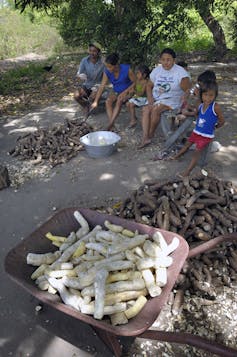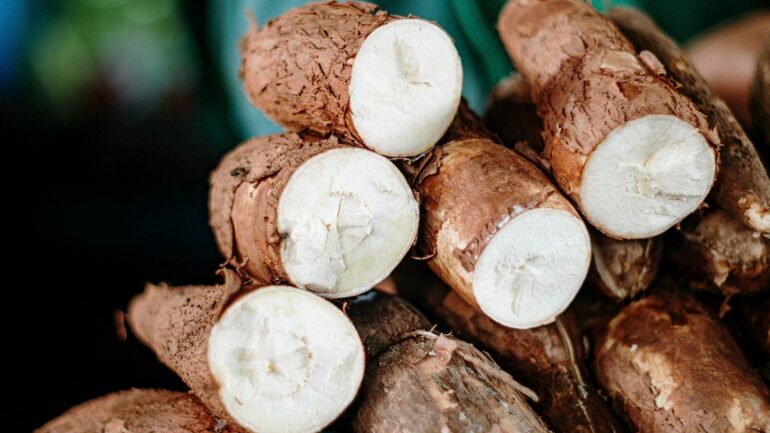The three staple crops dominating modern diets – corn, rice and wheat – are familiar to Americans. However, fourth place is held by a dark horse: cassava.
While nearly unknown in temperate climates, cassava is a key source of nutrition throughout the tropics. It was domesticated 10,000 years ago, on the southern margin of the Amazon basin in Brazil, and spread from there throughout the region. With a scraggly stem a few meters tall, a handful of slim branches and modest, hand-shaped leaves, it doesn’t look like anything special. Cassava’s humble appearance, however, belies an impressive combination of productivity, toughness and diversity.

People preparing to process cassava, with some peeled tubers in the foreground.
Philippe Giraud/Corbis Historical via Getty Images
Over the course of millennia, Indigenous peoples bred it from a weedy wild plant into a crop that stores prodigious quantities of starch in potatolike tubers, thrives in Amazonia’s poor soils and is nearly invulnerable to pests.
Cassava’s many assets would seem to make it the ideal crop. But there’s a problem: Cassava is highly poisonous.
How can cassava be so toxic, yet still dominate diets in Amazonia? It’s all down to Indigenous ingenuity. For the past 10 years, my collaborator, César Peña, and I have been studying cassava gardens on the Amazon River and its myriad tributaries in Peru. We have discovered scores of cassava varieties, growers using sophisticated breeding strategies to manage its toxicity, and elaborate methods for processing its dangerous yet nutritious products.
Long history of plant domestication
One of the most formidable challenges faced by early humans was getting enough to eat. Our ancient ancestors relied on hunting and gathering, catching prey on the run and collecting edible plants at every opportunity. They were astonishingly good at it. So good that their populations soared, surging out of humanity’s birthplace in Africa 60,000 years ago.
Even so, there was room for improvement. Searching the landscape for food burns calories, the very resource being sought. This paradox forced a trade-off for the hunter-gatherers: burn calories searching for food or conserve calories by staying home. The trade-off was nearly insurmountable, but humans found a way.
A little more than 10,000 years ago, they cleared the hurdle with one of the most transformative innovations in history: plant and animal domestication. People discovered that when plants and animals were tamed, they no longer needed to be chased down. And they could be selectively bred, producing larger fruits and seeds and bulkier muscles to eat.
Cassava was the champion domesticated plant in the neotropics. After its initial domestication, it diffused through the region, reaching sites as far north as Panama within a few thousand years. Growing cassava didn’t completely eliminate people’s need to search the forest for food, but…



